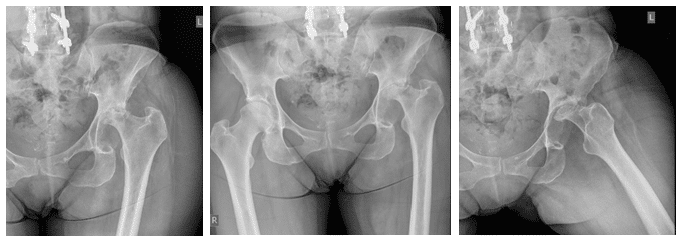Patient is a 68 year old male who came in 2010 by referral from another orthopedic surgeon. Patient complained of left hip pain that he stated had been bothering him for the past two years.
Patient had mentioned that he was hospitalized one year ago with a septic hip. When at the hospital, the patient had drainage, irrigation and debridement, and a needle aspiration of the left hip, which revealed that he had MRSA from a previous cervical and lumbar spine surgery done at an outside institution. Patient had come in with X-rays to review

X-rays reveal chronic arthritis of the left hip, which ispostinfectious
Also seen is shrinkage/resorption/absence of the left femoral head. X-rays also partially show fusion at L3-L4 and L4-L5.
During this initial visit the patient presented with sharp pain and tenderness over the left hip and the greater trochanter. The patient presented with a severely restricted range of motion and decreased strength in the lower left extremity.
Patient’s test results also showed that he was Vitamin D deficient. The Vitamin D deficiency along with the increase of severe pain, are typical signs and symptoms of an infected native hip joint. It was discussed with the patient that the best course of treatment would be a staged reconstruction of the left hip.
The course of treatment was discussed thoroughly with the patient, along with all of the possible risks included. The patient was put on 2,000 IU Vitamin D and was scheduled for Removal of left hip and placement of spacer.
It was explained to the patient that the staged reconstruction would entail at least two surgeries. The first surgery would include placement of an antibiotic spacer, and the second would be the removal of the spacer along with a Total Hip Arthroplasty (THA).
An antibiotic spacer is a mold made of cement mixed with antibiotics. The purpose of the antibiotics spacer is to place it directly into the hip so antibiotics are delivered directly to the site of the infection.
The advantage of an antibiotic spacer is that antibiotics which are directly at the site of an infection are much more effect and allow for a high local dose of antibiotics rather than receiving antibiotics intravenously.
Removal of Left Hip and Placement of Spacer was performed in 2010. This procedure included resection of the femoral head of the lower left extremity, debridement of the acetabulum and femoral canal, along with the placement of an antibiotic spacer.

X-Rays taken the day of surgery. X-rays show a Left Antibiotic Spacer
One month post-operatively, the patient came in for a follow-up. At this time, the patient appeared to be doing well and presented with no tenderness over the left hip upon examination. New X-rays were also taken and brought to be reviewed and revealed that the spacer and prosthesis were in good position.
Due to past medical history of MRSA, the patient was advised to continue antibiotics per ID andto obtain a left hip aspiration after stopping antibiotics to ensure the infection was gone. Upon next follow-up, surgery was schedule for left hip spacer removal and hip replacement.
Left Hip Spacer Removal and Left THA was performed early 2011.

X-Rays show revision left hip prosthesis post-operative
Patient came in one month after spacer removal and THA and was in good condition. Patient presented with no pain or tenderness, but did have restricted range of motion. Patient was advised to take Aspirin for any discomfort.
Upon subsequent follow-ups patient presented with minimal pain and was instructed to steadily increase weight bearing as directed per each follow-up.
About three months after left hip spacer removal and left hip revision THAthe patient was doing well and was weight bearing as tolerated. The patient however was experiencing atrophy of the lower left extremity and was advised to attend physical therapy to help strengthen his leg.
*Patient identifiers and dates changed to protect patient privacy.





